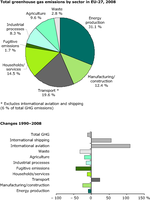
The figures shows the total greenhouse (GHG) emissions in the EU-27 by sector and the changes between 1990 and 2008

The figure shows the past and projected change in global surface temperatures.
If global greenhouse gas emissions would not be reduced, the 2°C target will be exceeded towards the middle of the 21st century. The horizontal 2°C target line takes into account warming of about 0.6 °C from pre-industrial to 1990. “Likely” ranges in average 2090-2099 warming for all six IPCC scenarios are shown on the right

These graphs show the trends in the use of material resources in EU-15 and EU-12 and municipal waste generation in EU‑27 compared with GDP and population.

This graph shows the intensity of forestry — net annual increment in growing stock and annual fellings of forest available for wood supply — 32 EEA member countries, 1990–2005.

This map shows the intensity of forestry - net harvesting rate in 2005.

This graph shows the resource use per person, by country in 2000 and 2007.

Temperature increase (above 1990 level) at which the various events could occur and an estimate of their impact. The impact scale has subjective qualifications (‘minor’, ‘notable’, ‘major’ and ‘devastating’), which were assigned on the basis of the geographical scale (from ‘regional’ to ‘continental’ and ‘global’) and the character of the damages (‘light’, ‘moderate’, ‘heavy’ or ‘extreme’). The level of scientific understanding, as well as the understanding of possible impacts for most of these events is low. The shapes and sizes of the ovals do not represent uncertainties in impact and temperature onset of eventualities and these uncertainties may be significant.

A compiled dataset on renewable energy trajectories extracted from the submissions of the Member States to the European Commission, and an accompanying document which summarises the main points of the data.

Land cover changes in Liechtenstein remained below the detection level of Corine Land Cover change methodology. In some large countries, dates of satellite images for regions may differ by several years

Land cover changes in Liechtenstein remained below the detection level of Corine Land Cover change methodology. In some large countries, dates of satellite images for regions may differ by several years

Origin of land uptake as % of total uptake

Drivers of urban land development ha/year
In some large countries, dates of satellite images for regions may differ by several years

The figure show the greenhouse gas emissions as tonnes CO2 - equivalent per person by country

The map show the marine aquaculture production relative to coastline length

-

Freight transport demand by mode - EU27

Percentage share of land freight transport between road and rail transport mode for EU12, EU15 and combined EU27.

Trends in air passenger transport demand and GDP. The two curves show the development in GDP and air passenger transport volumes, while the columns show the level of annual decoupling. Green indicates faster growth in GDP than in transport while red indicates stronger growth in transport than in GDP.
Aviation passenger demand data are provisional estimates from the European Commission DG MOVE for domestic and intra-EU27 aviation. GDP data for Lichtenstein is not included as it is not available.
The ratio of annual growth of passenger transport to GDP, measured in 2000 prices, determines the amount of coupling between GDP and transport. The decoupling indicator, depicted by the green bars, is calculated as unity minus the coupling ratio; so a positive score indicates decoupling (i.e. transport demand grows less slowly than GDP), with a negative score showing the opposite (i.e. transport demand outpaces GDP growth)

The graph shows the change in energy-related emissions of ozone precursors (NOx, NMVOC, CO and CH4) each weighted by an ozone formation factor prior to aggregation to represent their respective ozone forming potentials. The relative impact of the combined contribution of NOx, NMVOC, CO and CH4 to ozone formation can be assessed based on their tropospheric ozone forming potentials (TOFP): nitrogen oxides 1.22, non-methane volatile organic compounds 1.0, carbon monoxide 0.11 and methane 0.014 (de Leeuw 2002).

The emissions of ozone precursors (NOx, NMVOC, CO and CH4) are each weighted by an ozone formation factor prior to aggregation to represent their respective ozone forming potentials. The relative impact of the combined contribution of NOx, NMVOC, CO and CH4 to ozone formation can be assessed based on their tropospheric ozone forming potentials (TOFP): nitrogen oxides 1.22, non-methane volatile organic compounds 1.0, carbon monoxide 0.11 and methane 0.014.